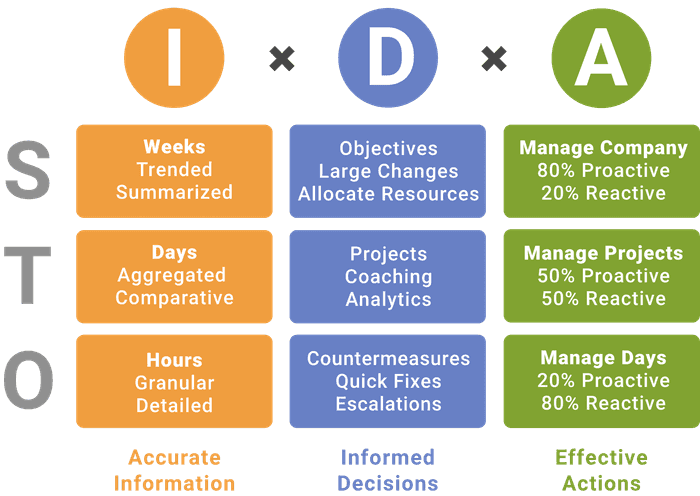
IDA: Information, Decision, Action
Most companies focus primarily on results, which are inherently rooted in the past. Instead, focus on the factors that drive results: Information, Decision, and Action. Establish behaviors that optimize the inputs (Information, Decision, Action) and the outputs (Results) will take care of themselves.
Download the IDA TopicBenefits
IDA is one of the most effective ways to improve results in almost anything you do. It is an improvement methodology that is simple enough to be understood by anyone and broad enough to serve as a framework for driving results at every level of your company.
Essentials
What Is IDA?
Rather than spending time trying to manage results, which are by their very nature rooted in the past, IDA emphasizes the three factors that drive results:
| Factor | Description |
|---|---|
Information | Information is the foundation and starting point of IDA. Excellent information (i.e., accurate, relevant, and easy-to-understand) is a precondition for effective decision making. |
Decision | Decision is the pivot between Information and Action. It is the moment in time when Information is reviewed and a course of Action is decided. Decision is amplified through great meetings and aligned across the business through structured review. |
Action | Action is where theoretical possibilities are transformed into tangible progress; where targeted and proactive actions further your goals and the goals of your organization. |
The IDA framework can be expressed as an equation, much like OEE. This highlights a critical aspect of effective improvement - all three factors (Information, Decision, and Action) must be present and in balance to achieve optimal results.

A Simple IDA Example
Imagine you are a pilot and it’s your job to safely fly passengers from Chicago to Munich. In each of the following three scenarios, there is an IDA problem that prevents you from meeting your objective:
- The gauges are inaccurate or broken (Information problem)
- The gauges are accurate but you don’t look at them (Decision problem)
- The gauges are accurate and you look at them; but you don’t make any adjustments to the flight controls (Action problem)
In other words, all three factors (Information, Decision, and Action) are necessary in order to achieve a good result. Establish behaviors that optimize the inputs (Information, Decision, Action) and the outputs (Results) will take care of themselves.
Key Insights
IDA Applies Across Your Business
Every level of your business (Strategic, Tactical, and Operational) can benefit from IDA. The scope and nature of each factor changes as it is applied to different STO levels, as shown below.

Information Insights
Many companies capture reams of information, much of which is not used or useful. Measure only what you need to make effective decisions. Audit what you capture to verify value. Eliminate everything else.
Use Vorne XL to curate relevant data into dashboards that are easily understood by all stakeholders.
Decision Insights
Establish standardized processes aligned across the business to make high-quality, timely, and effective decisions (i.e., structured review and structured improvement).
The key to effective decisions is great meetings. Great meetings are standardized, positive, energetic, action-oriented, collaborative, and forward-focused. Individuals don’t win. The best idea wins.
Action Insights
Apply decisions quickly and consistently with accountability for tangible progress. Complete every action fully or escalate it to a higher level.
Prefer small, frequent, and incremental actions in the spirit of agile. Increments should be short enough to keep people engaged and long enough to have a meaningful impact.
Action Plan
- 1Train your team on IDA as a practical methodology for achieving results that can be consistently repeated and applied to each improvement project.
- 2Structure meetings around reviewing good Information, collaboratively coming to a Decision, and planning concrete Actions.
- 3Experiment with IDA in your daily routine. Learn to recognize when meetings drift off course and use IDA as a touchstone for focus.
Note: IDA was developed through pioneering work by OptimumFX, who are UK-based thought leaders and experts on manufacturing improvement.

